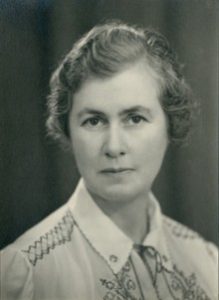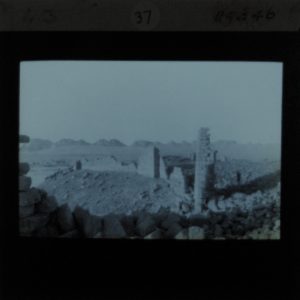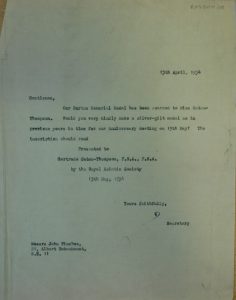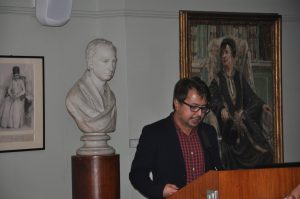Gertrude Caton-Thompson
As we prepare to bestow the Burton Memorial Medal on new recipients this year, I thought I would take a look back at the recipient of just under seventy years ago. In 1954 the Medal was awarded to Gertrude Caton-Thompson, an archaeologist, whose birthday falls at the beginning of next week. She was born on 1st February 1888. Though her father died when she was five years old, he had ensured that as an adult she would be financially independent. After being educated in Eastbourne and Paris, she lived in London enjoying an active social life. She travelled with her mother to Egypt in 1911, a trip which is said to have sparked her interest in archaeology.
During the War, in 1917, she was employed at the Ministry of Shipping and, as a senior secretary, attended the Paris peace conference. However she rejected a permanent civil service career and in 1921, began her archaeological studies under Flinders Petrie, the Egyptologist, at University College, London. She undertook excavations with him at Abydos, Egypt, that year, before moving on to Newnham College, Cambridge, for further study. She returned to Egypt with Petrie in 1924 and then embarked on her own excavations at the site of a predynastic village at Hamamiyyah where she was the first to discover the stratified remains of Badarian civilization, a very early agricultural community. She returned again to Egypt in 1925 with the geologist Elinor Gardner to the desert margins of Lake El Faiyûm, discovering two previously unknown neolithic cultures.

In 1929, at the request of the British Association for the Advancement of Science, she went to investigate the monumental ruins in Zimbabwe. She confirmed the conclusion of David Randall-MacIver’s excavation in 1905, that these ruins belonged to an indigenous African culture. This went against the prevailing thinking that they were of oriental origin. She proved that the ruins dated back to the 8th or 9th centuries and produced evidence of Zimbabwean trade links across the Indian Ocean. These ruins, which have become to be known as Great Zimbabwe from the Shona word for the site, are believed to have been constructed by the Shona people and used by a local monarch. In 1980, when the country gained independence, they chose the name Zimbabwe in honour of their previous civilization.
Caton-Thompson and Elinor Gardner teamed up again in 1930 to excavate prehistoric sites at Kharga Oasis, in the Egyptian Sahara, the first team to excavate these oasis sites. In 1937, she switched her area of study, from Africa to the Hadramaut in Southern Arabia, working with Elinor Gardner and Freya Stark (whose birthday is 31st January) to excavate the Moon temple and tombs of the 4th and 5th centuries BCE at al-Huraydah. It was about these excavations that Caton-Thompson chose to deliver her Burton Memorial Lecture entitled ‘An Archaeologist in the Hadramaut’.

She retired from fieldwork after the Second World War but continued to visit excavations in east Africa and pursue her research. She lived in Cambridge, with her friend Dorothy Hoare and Dorothy’s husband, Michael de Navarro. When they retired they all moved to Court Farm, Broadway, Worcestershire, where Gertrude Caton-Thompson died in April 1985, aged 97.
Her Burton Memorial Medal was presented at the Anniversary General Meeting by the Royal Asiatic Society President, Sir Ralph Turner, himself a recipient of the Triennial Gold Medal the previous year (1953). Unfortunately we have little archival material for the awarding of the Medal to Gertrude Caton-Thompson – just a single letter from The Secretary, Royal Asiatic Society, to John Pinches, medal-makers, to inform them that the Burton Memorial Medal had been awarded to Gertrude Caton-Thompson and to provide the inscription to be engraved on the Medal. However more archival material about her life can be found at the Royal Geographical Society.

Yesterday, Thursday 27 January, the Society was delighted to host a hybrid lecture by Dr Farouk Yahya (SOAS), titled ‘Talismans with the names of the Seven Sleepers of Ephesus/Ashab al-Kahf in Southeast Asia’. In the Christian and Islamic traditions, the Seven Sleepers is a legend which, in its outlines, tells the story of a group of youths who hid in a cave to escape religious persecution, emerging several hundred years later. After explaining the background of the tale, Farouk introduced a fascinating study in material culture and the circulation of knowledge over a thousand-year period, tracing the transmission of the story of the Seven Sleepers across the Malay world through its depiction on religious and magical talismans. Farouk’s lecture was followed by a lively question-and-answer session, and those who attended in person were also able to enjoy refreshments and the opportunity to ask questions in a more informal setting.

Earlier yesterday evening, Dr Philip Jagessar (University of Nottingham) delivered an online lecture for the Warburg Institute, titled ‘Orienting Imperialism: The Royal Asiatic Society’s Miscellany of Maps’. Philip’s lecture was based upon research he completed last year as part of a Harley Fellowship in the History of Cartography, which was dedicated to surveying the Society’s map collection and assessing its significance for researchers. Philip explained how the Society acquired maps over the centuries, chiefly through member donations but also through its international connections to other Asiatic societies across Europe and South and East Asia. The main themes represented in the collection reflected the wider interests of the Society and its members – including language, archaeology, and geopolitics. Philip highlighted the diversity of subjects and places depicted in our map library, and identified two private collections from notable travellers, John Baddeley and Douglas Carruthers.

Philip has previously written about some of our most interesting maps on this blog (for example, see here: https://royalasiaticsociety.org/translating-an-ottoman-railway-map/), and his discoveries have already helped us make a start with cataloguing our map collection online. We look forward to hearing more about his research at our Collections Evening on Thursday 24 March, when he will be one of our three presenters, along with Ian Herbertson and Jean-Baptiste Lamontre. Stay tuned for further information!
